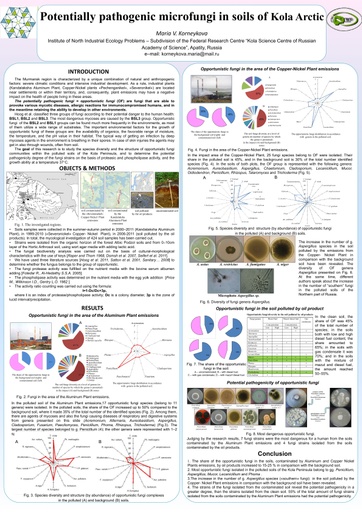Search
pdf Рotentially pathogenic microfungi in soils of Kola Arctic Popular
1812 downloads

Maria Korneykova
Institute of North Industrial Ecology Problems – Subdivision of the Federal Research Centre “Kola Science Centre of Russian Academy of Science”
 In the last decades a lot of saprothrophic microfungal species have been shown to display the capacity of potential pathogens for man. Soil - is the main reservoir of opportunistic fungi of this type. Warming of the climate will inevitably greatly affect the spread of potentially pathogenic fungi because it is precisely these groups of species that attain the optima in their growth at elevated temperatures (above 25 °C). Probably that warming of the climate in the Northern latitudes is expected to enhance the development of soil fungi potentially dangerous for human. Our studies carried out in the Nothern part of Russia (Kola Peninsula) for many years have demonstrated that populations of cultivated opportunistic microfungi become considerably more numerous in soils. Modern biosphere is characterized by appearance of extensive areas of temperature, elevated as compared to that average for the respective zone, i.e., urban ecosystems and near the industrial plants. We have found that in these areas the level of cultivated microfungi typical of more southern soils is higher. The pronounced increase in their occurrence in urban soils as compared to zonal soils of arctic and boreal latitudes is noted regarding Aspergillus fumigatus, A. flavus, A. niger, Paecilomyces variotii, Fusarium oxisporum, etc., i.e., species which could be the causative agents of deep human mycoses.
In the last decades a lot of saprothrophic microfungal species have been shown to display the capacity of potential pathogens for man. Soil - is the main reservoir of opportunistic fungi of this type. Warming of the climate will inevitably greatly affect the spread of potentially pathogenic fungi because it is precisely these groups of species that attain the optima in their growth at elevated temperatures (above 25 °C). Probably that warming of the climate in the Northern latitudes is expected to enhance the development of soil fungi potentially dangerous for human. Our studies carried out in the Nothern part of Russia (Kola Peninsula) for many years have demonstrated that populations of cultivated opportunistic microfungi become considerably more numerous in soils. Modern biosphere is characterized by appearance of extensive areas of temperature, elevated as compared to that average for the respective zone, i.e., urban ecosystems and near the industrial plants. We have found that in these areas the level of cultivated microfungi typical of more southern soils is higher. The pronounced increase in their occurrence in urban soils as compared to zonal soils of arctic and boreal latitudes is noted regarding Aspergillus fumigatus, A. flavus, A. niger, Paecilomyces variotii, Fusarium oxisporum, etc., i.e., species which could be the causative agents of deep human mycoses.
The share of the opportunistic fungi increase up to 15% in the zones of the Aluminum and Copper-Nickel Plants emissions comparable to the background soil has been revealed. The majority of the fungi species belongs to the following genera: Penicillium, Aspergillus, Mucor, Lecanicillium, Phoma and Cladosporium. The structure of the fungal complexes has changed in the polluted soil, that is, the species abundance and the frequency of the opportunistic fungi occurrence have increased. 55% of the investigated fungi strains distinguished from the soils contaminated by the Aluminum Plant emissions had the pathogenicity properties compared to the fungi strains of the same species distinguished from the clean soil. The most dangerous for a human's health were Amorphotheca resinae, Aspergillus fumigatus, A. niger, Paecilomyces variotii, Penicillium commune, P. purpurogenum, Trichoderma viride isolated from the soils contaminated by the Aluminum Plant emissions; and P. aurantiogriseum, P. glabrum, P. janthinellum, P. lanosoviride, Rhizopus nigricans isolated from the soils contaminated by the Copper-Nickel Plant emissions.
This makes it necessary to carry out monitoring of these fungal populations in soils.


